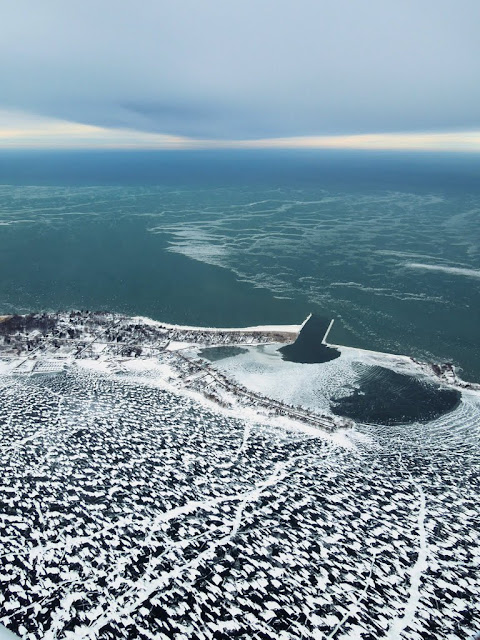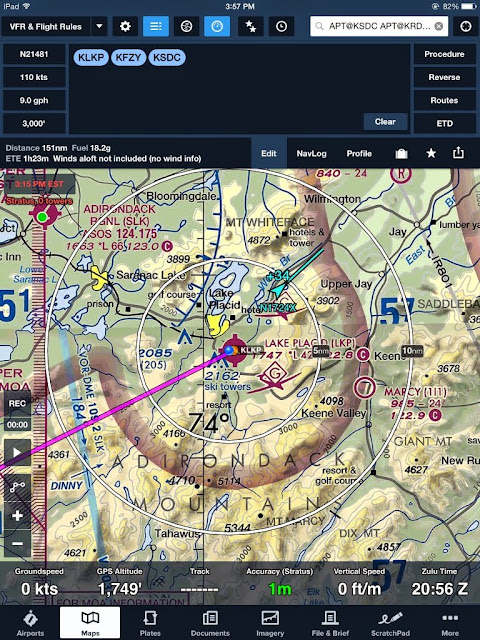| Date | Aircraft | Route of Flight | Time (hrs) | Total (hrs) |
| 17 Jan 2015 | N21481 | SDC (Sodus, NY) - LKP (Lake Placid, NY) - SDC | 3.9 | 1369.7 |
Eight years ago on a cold January day, I beheld the stark winter beauty of the Adirondack Mountains for the first time. Today, weather conditions permitted a rare January trip out of the local area and I seized the opportunity for a return.
Sodus Bay was mostly frozen over, the ice adorned with curiously patterned tufts of windblown snow.
Clouds along the route were variable, changing from nonexistent to broken.
Although surface winds were out of the southeast, flight on an east heading at 5,500' yielded a true airspeed of 125 knots and a ground speed of 146 knots. Clearly, there was a significant shift in wind direction below. There was also an inversion present; the outside air temperature at the surface was -2°C (28°F) while the air temperature nearly a mile above the surface was a remarkable 4°C (39°F).
Warrior 481 flew hands off in smooth air most of the way to the mountains and, as I sat with arms folded comfortably across my chest, I was suddenly struck by the often invoked "magic carpet" analogy.
Our route was direct from Sodus to Piseco (above), where we turned northeast toward Lake Placid.
Flying along the same route taken eight years ago, our course ran parallel to Indian Lake.
Nearer to the High Peaks, we slipped under a stratus deck that varied from broken to solid overcast. The layer was entirely unperturbed and gave no indication of any turbulence caused by the wind aloft burbling through the peaks.
The air remained entirely smooth as we navigated among the peaks.
From the sectional chart, I chose a route through this valley between Mount Marcy (the highest peak in the Adirondacks) and Dix Mountain (the sixth highest). This path took us east of Lake Placid, around some of the higher peaks, and allowed access to Lake Placid from the northeast near Whiteface Mountain.
I usually try to keep airplane bits out of my photos, but sometimes a stray wingtip helps place the scene into better context.
Sunbeams occasionally broke through the stratus deck to provide some color.
Upon reaching Whiteface, I turned southwest toward Lake Placid and began a descent toward the airport. Tiny black dots zipped along white thoroughfares traced on the slope of the mountain.
Lake Placid sits in a broad valley partially ringed by large peaks to the southwest, south and east.
The airport is south of town. Beyond, low peaks herald the presence of higher mountains. My inbound radio call was answered with a wind advisory from the airport: winds were light and out of the north. Unicom wind advisories were relatively common when I was learning to fly, but they are unusual today. It was a nice change.
On downwind for runway 32, I flew past the Olympic ski jump towers adjacent to the airport.
I topped off the fuel at $4.95/gal, grateful to finally see aviation fuel prices dropping (as they have recently at Sodus and Le Roy, as well).
In the fall, we planned a club fly-out to Lake Placid. Though the activity had been my idea, I was unable to participate. Instead, we flew in the opposite direction, to Pontiac, to visit family. The mass arrival of Williamson Flying Club members on that beautiful fall day made quite an impression on the folks at Adirondack Flying Services. The guy who fueled my airplane remembered it and remarked on how cool it was to have so many airplanes arrive together. He encouraged us to come back in 2015.
Inside, the FBO had been completely remodeled since our last visit. When I asked if the work was recent, I was told that it happened three or four years previous. I was shocked that it had been so long since my last visit, but it had. Our last flight to Lake Placid took place in July of 2011. No wonder I was inspired to fly to Lake Placid; I was overdue.
Clearly, Lake Placid had already experienced a lot more snowfall than Rochester.
Preparing to depart for home, I saw something in Foreflight that I had never seen before.
It was my first time observing an ADS-B aircraft target appear in Foreflight, a Cirrus that overflew the field and only announced its presence on Unicom once I declared my imminent departure.
Knowing that I would have a headwind going home, I planned a more direct route that would take us through a set of MOAs. Though they are usually cold on weekends, I contacted Boston Center for flight following. We climbed to 6,500' to clear terrain with a large margin.
The farther we flew to the southwest, the more our initial anemic ground speed of 85 knots dwindled. By the time it dropped to 66 knots (!), we had cleared enough of the terrain that I was comfortable descending to 4,500'. This only picked up ten knots of groundspeed. The journey home was a long one, though not at all unpleasant
After a day spent surrounded by the stark monochrome of snow-covered mountains, appearance of warm color on the horizon hinted at the coming of a spectacular sunset.
The last hour home was flown in darkness. Near Oswego, our ground speed increased to a more expeditious 88 knots.
We were converging on Sodus with one of the club planes, Archer Eight Five X-Ray, and I decided to let the other aircraft land first. My concern about the surface winds was relieved by an AWOS broadcast of winds 170° at ten gusting to fifteen. Sure, a crosswind, but nothing unmanageable. The wind data served to highlight evidence of windshear; at 4,500', I was still flying with a headwind out of the west.
The AWOS lied (not for the first time). Ahead in Eight Five X-Ray, Mike advised that I was in for a wild ride. I was; the Warrior and I were buffeted by strong wind gusts from the right as we negotiated final approach to runway 10. I do not know the actual wind velocity at the surface, but it was much stronger than advertised. Though we landed smoothly enough, the strong broadside wind caused the tires to squawk a couple of times before the weight of the airplane finally settled fully on the landing gear. It seemed a terrible way to treat a set of good tires.
Despite the lousy conditions at home, it is always a pleasure to visit the mountains and Lake Placid and I am grateful for decent weather that provided the opportunity.







































I never get tired of the sunset photos. Great pics along your route, much different terrain than here along the coast. The wind Gods always collect...one must pay for the gracious tailwinds we sometimes enjoy. ;)
ReplyDeleteYes, the do indeed, Gary! The trick is to not be surprised by them! Though, OK, I did not expect my ground speed to be quite so low on the return. The bright side? Plenty of time to enjoy that sunset.
DeleteMan, that's some seriously gorgeous scenery. We rarely get in much winter XC time ourselves so I can really appreciate what you were able to take advantage of. Shoddy groundspeed aside, looks like it was an awesome day to take a ride on that carpet.
ReplyDeleteIt was a great day for winter flying! In this one flight, I flew roughly double the hours I was able to get in January 2014, so I consider the whole day to be a win.
DeleteNice pics as usual. Wild rides keep us humble, or at least they do me. Recently on a training flight I landed well short of the 1000 foot markers, but there was such a serious wind speed shift due to mechanical turbulence that the plane went flying agai just as I passed them. Instructor said the IAS jumped 20 knots, which when coupled with full elevator back pressure resulted in a sudden 100 feet of altitude. Excellent learning... Let's just say that got my attention.
ReplyDeleteThanks!
DeleteYup, an unplanned lift-off will definitely get your attention! Though the old adage is usually applied to taildraggers, it's a good reminder that the flight is not done until the airplane is tied down or put back into the hangar!
Something similar happened to me while flying with a safety pilot earlier this month. "That was the softest bounce I've ever experienced!" exclaimed my safety pilot. But it wasn't a bounce, it was a sudden, intense wind gust that occurred just a moment after we touched down in a full stall landing and it was enough to make the airplane fly again.